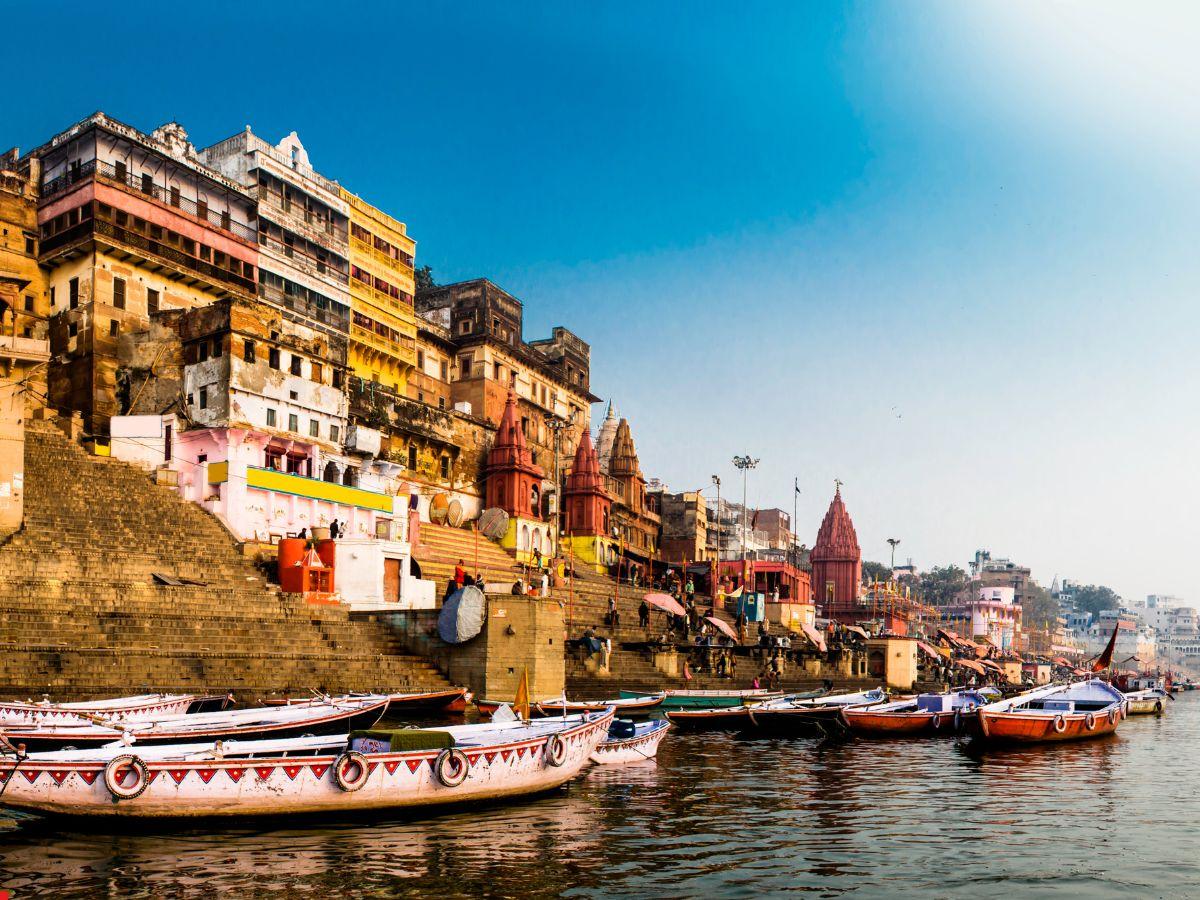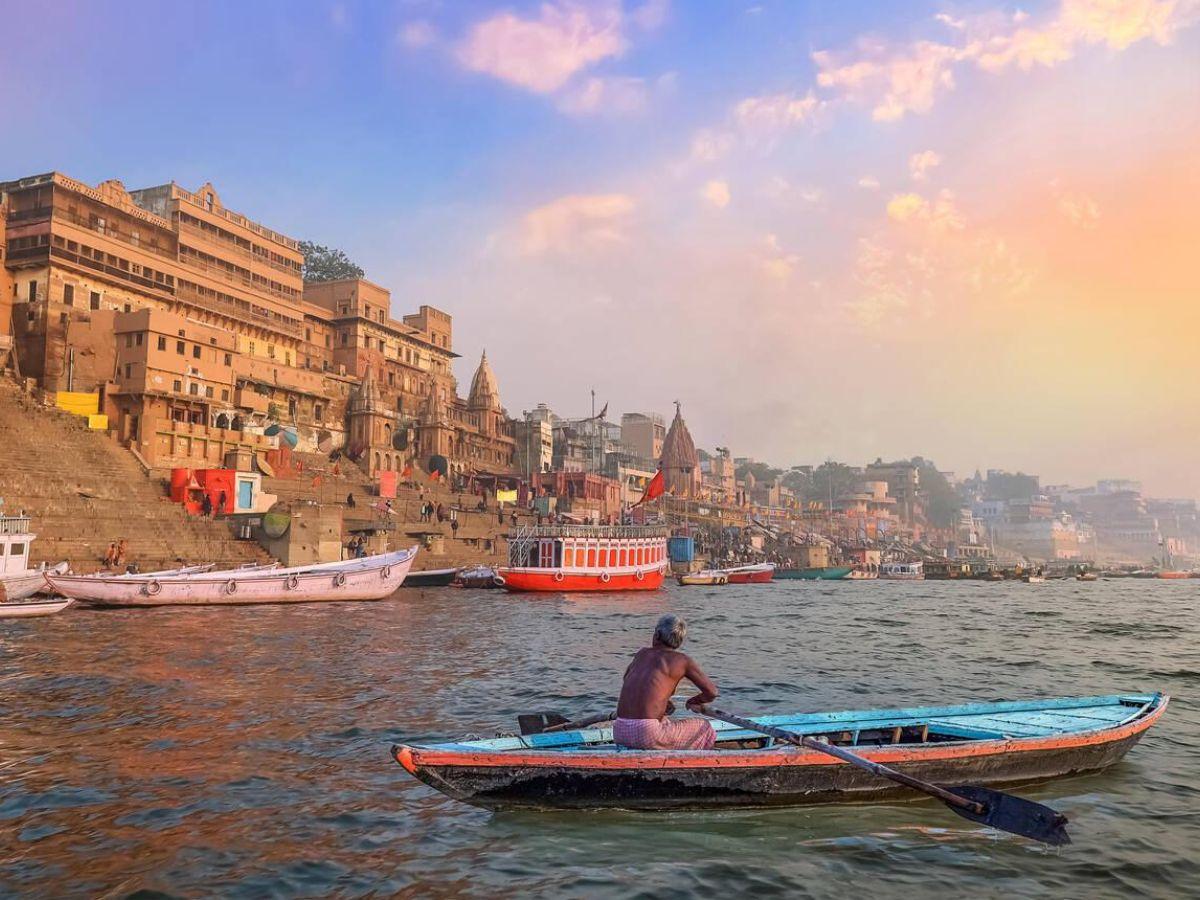9 Hidden gems in Varanasi: Explore the unseen side of the holy city

By The Hosteller
17 Jul, 2024
Varanasi is so much more than just the crowded ghats and famous temples tourists flock to. Nestled in the maze of narrow alleys are hidden gems waiting to be uncovered by those seeking to explore the unseen side of this holy city.
Beyond the well-trodden tourist circuit of Assi Ghat and Kashi Vishwanath temple lies a different Varanasi - crumbling forts from ages past, and shrines forgotten by time.
This ancient city hides many secrets in its winding streets for those willing to venture off the beaten path. Lush orchards where peacocks dance, dilapidated havelis with exquisite murals, sacred ponds revered by locals but unknown to outsiders - Varanasi has no shortage of wonders for the intrepid explorer.
So, let us take you to the 9 hidden gems of Varanasi that will unveil this holy city like never before.
1. Sarnath
Sarnath, approx 10 kilometres away from Varanasi (about 30 minutes by car), is one of Buddhism's four holiest destinations. In this place, Gautama Buddha gave his first sermon after attaining enlightenment at Bodh Gaya.
The Dhamek stupa, believed to be where Buddha preached his first sermon, has stood right around his ceremony spot since about the 3rd century BCE. The Sarnath Archaeological Museum is a must if you get there.
It has a spectacular collection of extraordinary Buddha statues and carvings that can make your visit memorable. Other places to explore in this sacred city, such as Dhamek Stupa, Mulagandha Kuti Vihar, Chaukhandi Stupa, Ashoka Pillar, and the Sarnath Archaeological Museum.
How to reach?
It should take about 25 minutes to drive from Varanasi to Sarnath via Varanasi Cantt Overbridge. The distance is approximately 5.9 miles.
Tip: Allow extra time for traffic, especially during peak hours. Also, be sure to check the weather conditions before you go, as they can affect the driving time.
Sarnath, Varanasi | Credits: Canva
2. Lakhaniya Dari
Placed amidst nature's bounty in Mirzapur district is Latifpur, Lakhaniya Dari, a cascading waterfall providing a much-needed break from hectic lives. A 150-metre fall descending into Lakhaniya Valley makes for an impressive view. The surrounding lush greenery and the soothing sound of water creates a tranquil atmosphere, perfect for nature lovers and photography enthusiasts.
The area around the waterfall offers opportunities for short treks and picnics, making it an ideal spot for a day trip or weekend getaway. Lakhaniya Dari is located approximately 54 km from Varanasi. From Mirzapur, you can hire a taxi or take a local bus to reach the site. The journey takes about 1 hour, depending on the mode of transport and road conditions.
How to reach?
From Varanasi city, take a taxi or bus to Ahraura, which is about 40 km away. From Ahraura, Lakhaniya Dari is approximately 11 km. Hire a local vehicle or trek to the waterfall. The scenic route ensures a pleasant journey through the rural landscape.
Disclaimer: It is advisable not to visit this place during the monsoon season (typically July to September) due to increased water flow, slippery terrain, and potential safety hazards. The best time to visit is from October to March when the weather is pleasant and the water flow is moderate.
Lakhaniya Dari, Varanasi | Credits: Canva
3. Bharat Kala Bhavan museum
Situated on the Banaras Hindu University campus, Bharat Kala Bhavan houses one of the best collections of Hindu and Buddhist art in India. The huge hall contains more than 100,000 paintings, sculptures, textiles, and other artefacts that span four millennia.
Other things include a Mughal miniature painting from Mughal Empire time, a black stone-carved figure of Buddha dating back to the 6th century, and works done by modern Indian artists like Jamini Roy. In fact, there is an art gallery at this museum where avant-garde paintings and sculptures are displayed.
How to reach?
It should take about 31 minutes to drive from Varanasi to Bharat Kala Bhavan museum. The distance is 8.4 kilometers.
Bharat Kala Bhavan, Varanasi | Credits: Canva
4. Chet Singh ghat
Situated along the sacred Ganges River in Varanasi, Chet Singh Ghat stands as a testament to the city's rich history and architectural grandeur. This ghat is distinguished by the impressive Chet Singh Fort perched atop it, offering visitors a unique blend of spiritual ambiance and historical significance.
Built in the 18th century, the ghat and fort played a crucial role in the 1781 battle between Warren Hastings and Chet Singh, the ruler of Varanasi. Today, it serves as a relatively peaceful haven compared to some of the busier ghats in the city.
The fort's intricate Rajasthani architecture, featuring ornate balconies and arched windows, provides a picturesque backdrop for those seeking to experience Varanasi's cultural heritage. Visitors can climb up to the fort for panoramic views of the Ganges and the city skyline, making it an excellent spot for photography, especially during sunrise and sunset.
How to reach?
It is situated approximately 6 km from Varanasi junction, which takes around 25 minutes.
Chet Singh ghat, Varanasi | Credits: Canva
5. Ramnagar fort
The Ramnagar fort, an imposing structure built with red sandstone in the 18th century, stands tall on the eastern bank of the Ganges in Varanasi. It was once the residence of Kashi Naresh, the king of Varanasi, but now it houses a captivating museum.
Inside the museum, you'll find a collection of old carriages, palanquins (elaborately decorated covered seats), royal furniture, and an armoury. Don't miss climbing up to the top of the fort for awe-inspiring views of the Ganges and the city.
Museum entry timings and fees
- Timings: 10:00 AM to 5:00 PM (Closed on Sundays and major Indian festivals like Holi and Diwali)
- Entry fee for Indian citizens is Rs. 20 per person and for foreigners it is Rs. 150 per person.
How to get there?
Reaching Ramnagar Fort involves crossing the Ganges River. Here are a couple of options:
- By Auto rickshaw: You can easily hire an auto rickshaw from any place in Varanasi to reach the fort.
- By Boat: Take a boat ride across the Ganges from Varanasi to reach the fort. This is a scenic option, especially during sunrise or sunset.
Ramnagar fort | Credits: delhiheritagem, Instagram
6. Chunar fort
Perched on a rocky hill roughly 40 kilometres southwest of Varanasi city centre, Chunar Fort is a stunning example of India's rich cultural heritage. Its architecture is a unique blend of Hindu, Afghan, and Mughal styles, with intricate carvings, beautiful arches, and massive walls that speak to the skill of the craftsmen who built it.
The fort's striking red sandstone façade gives it a distinctive appearance, and its strategic location offers breathtaking views of the surrounding landscape.
Chunar Fort has a long and fascinating history that dates back to the 11th century. It's been a prized possession for various dynasties, including the Mauryas, Guptas, and Mughals, who recognized its importance in controlling the region. The fort has played a significant role in many historical events, including the Revolt of 1857, and has been the site of numerous battles and sieges.
How to reach?
It should take about 57 minutes to drive from Varanasi to Chunar Fort via SH 74. The distance is 17.8 miles.
Chunar fort, Varanasi | Credits: Canva
7. Jantar Mantar
Jantar Mantar lies hidden amidst narrow lanes in Varanasi’s old city, an ancient observatory established by Jaipur’s Maharaja Jai Singh II. Unlike Jaipur’s counterpart, however, this astronomical establishment represents an interesting confluence between astronomy and architecture. A huge sundial and other astronomical instruments shed light on the scientific achievements of ancient India.
Varanasi’s Jantar Mantar comprises a variety of tools for measuring time, charting celestial movements, and observing various astronomical events. The most prominent among these instruments is the Samrat Yantra, an enormous sundial that measures time with accuracy to seconds. Other such instruments include the Jai Prakash Yantra and the Nadivalaya Yantra, which support the notion that ancient India had profound knowledge of astronomy.
How to get there?
To reach Jantar Mantar in Varanasi, take a taxi or rickshaw from Varanasi Junction (approximately 6 km). It is located near the Dashashwamedh Ghat. Alternatively, you can hire a boat to Dashashwamedh Ghat and walk from there. Local buses and autos are also available.
Entry fees for India citizens is Rs. 25 per person, foreigners Rs. 300 per person and for Children below 15 years the entry is free.
By blending scientific inquiry with spiritual curiosity, Jantar Mantar embodies India's rich tradition of astronomical exploration, where the pursuit of knowledge meets the mysteries of the universe.
Jantar Mantar, Varanasi | Credits: Canva
8. Sampurnanand Sanskrit university
Sampurnanand Sanskrit Vishwavidyalaya, a renowned institution in the spiritual hub of Varanasi, Uttar Pradesh, boasts a rich history dating back to 1791. The university's implementation of an examination system in 1880 likely solidified this focus.
Treasure trove of knowledge
Sampurnanand Sanskrit Vishwavidyalaya's reputation as a leading Sanskrit university is well-deserved. It offers a diverse range of undergraduate and postgraduate programs, attracting students from across India and beyond.
One of its most prized possessions is the iconic Saraswati Bhavan Granthalaya building, constructed in 1894. This library houses a treasure trove of over 100,000 manuscripts, including rare and ancient texts.
Experience sanskrit culture
Visitors to Sampurnanand Sanskrit Vishwavidyalaya can immerse themselves in the world of Sanskrit language and culture through various exciting activities. These include:
- Attending lectures and workshops on Sanskrit language and literature.
- Exploring the university's museum, which showcases a vast collection of artefacts and exhibits on Indian culture and history.
- Visiting the Saraswati Bhavan Granthalaya library and marvelling at its extensive manuscript collection.
- Participating in cultural events and festivals, such as the annual Sanskrit Festival.
- Taking a guided tour of the university's historic campus, featuring beautiful architecture and scenic gardens.
A vast network for sanskrit education
Adding to its significance, Sampurnanand Sanskrit Vishwavidyalaya is affiliated with over 600 colleges across India. This vast network plays a crucial role in promoting and preserving Sanskrit education throughout the country.
Sampurnanand Sanskrit university, Varanasi | Credits: mahakal_ka_ladla999, Instagram
9. Lamhi village
Lamhi village, a peaceful haven steeped in literary history, lies roughly 15 kilometres north of Varanasi. This is the birthplace of Dhanpat Rai Srivastava, better known by his pen name Munshi Premchand, a towering figure in Hindi literature.
A literary legacy
Premchand's prolific writing career resulted in over 300 titles. Some of his most popular works include:
- Godan: A powerful novel highlighting the plight of poor farmers in rural India.
- Idgah: A poignant story exploring themes of poverty and social injustice.
- Seva Sadan: A thought-provoking novel critiquing the social and educational systems of his time.
A glimpse into literary inspiration
Visit Lamhi to gain insights into the life and surroundings that shaped this literary giant. Explore Premchand's former residence, now a memorial museum. Here, you'll find his personal belongings, including furniture he crafted himself.
Lamhi offers more than just a literary connection. Consider getting on a village tour, a fantastic opportunity to experience the essence of rural life in India firsthand. Interact with locals, witness traditional practices, and gain a deeper appreciation for the very world that inspired Premchand's powerful stories.
How to reach?
It should take about 23 minutes to get from Varanasi to Lamhi village via NH 28.
Lamhi village, Varanasi | Credits: Canva
Conclusion
Hidden, forgotten corners in Varanasi, from serene gardens to decaying forts overlooking the Ganges, are the perfect way to escape its ancient spiritual alleys. These lesser-known places offer a glimpse into the many forms of culture, art, nature, and history that coalesce in this everlasting city.
While on your visit to Varanasi, explore these secret locations; they will reveal another aspect of the holy city that is hidden from sight by tourists who prefer going to iconic sites. Allow yourself to be astounded by obscure gems that unveil infinite fascination with many aspects of Varanasi.
thehosteller







